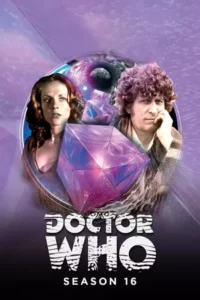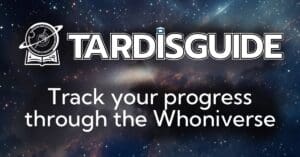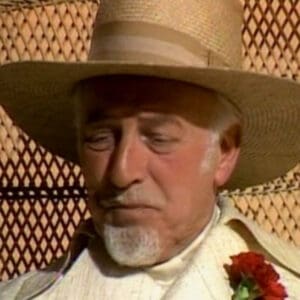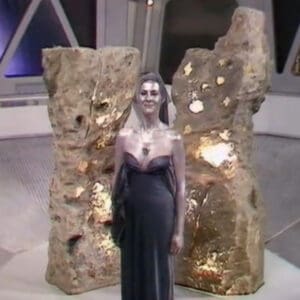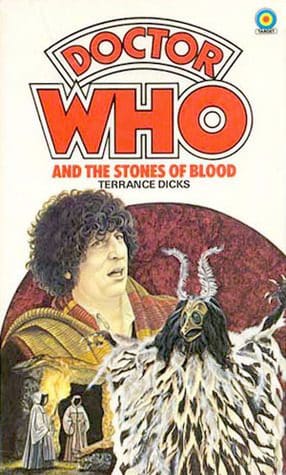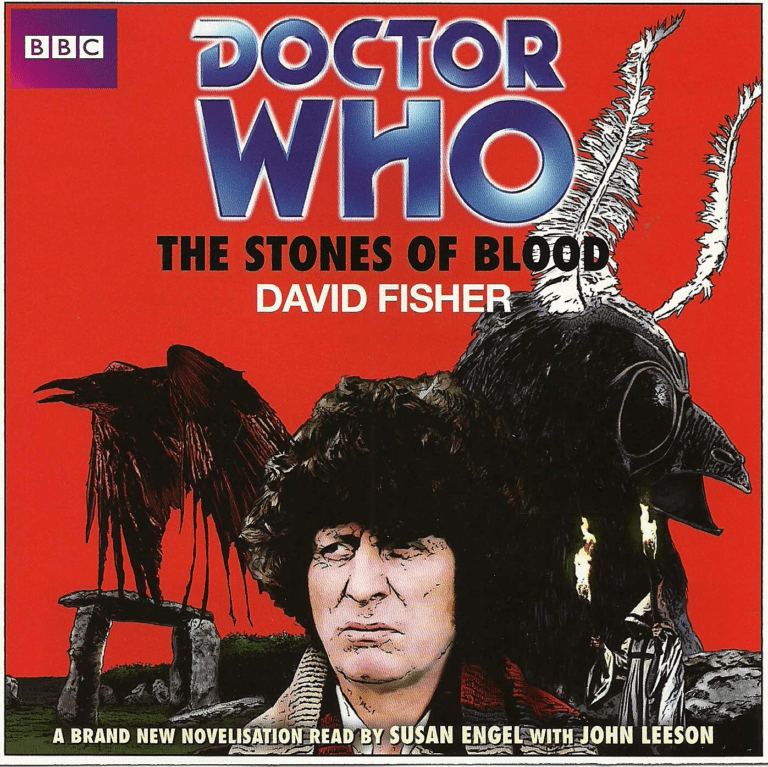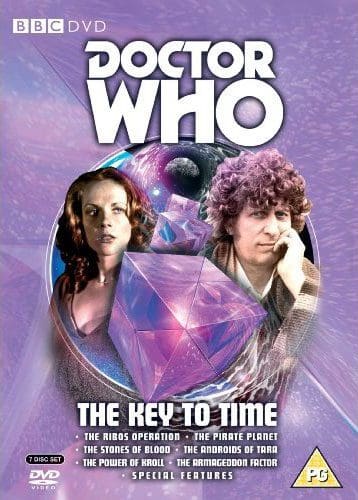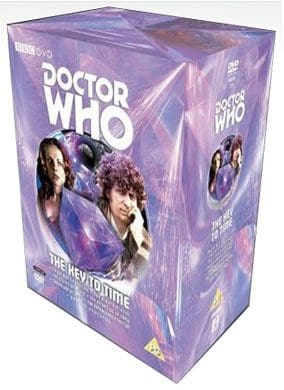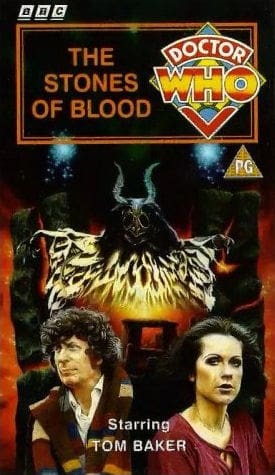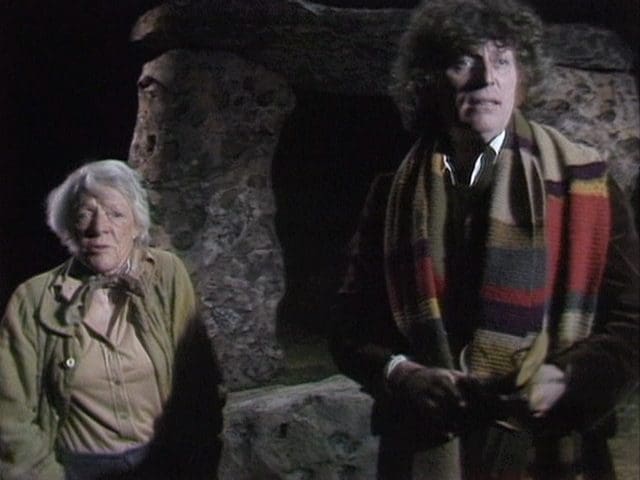
Classic Who S16 • Serial 3 · (4 episodes)
The Stones of Blood
Reviews and links from the Community
This review contains spoilers
Review of The Stones of Blood by WhoPotterVian
So the Doctor(Tom Baker) and Romana (Mary Tamm) have found two of the segments of the Key to Time. Now onto the third segment: the segment found in The Stones of Blood. The Stones of Blood is the one hundredth Doctor Who story but unlike 2009's Planet of the Dead it is never acknowledged in the story. It is weird to think there had been one hundred Doctor Who stories by this point and it is a credit to the classic series that they hadn't run out of ideas by this point.
Sadly, for the one hundredth story The Stones of Blood isn't one of the better serials. It is very imaginative but does at the same time it feels a little run of the mill. The serial sees the Doctor and Romana arrive on Earth during the then-present day, near a group of standing stones called The Nine Travellers. They find old archaeologist Professor Amelia Rumford (Beatrix Lehmann) and her partner Vivien Fay (Susan Engel) who are studying the stones and find dried blood on the ground. The stones are revealed as being a species from the planet Ogros called Ogri; they need blood in order to survive. Meanwhile, the Doctor is put on trial by the Megara - justice machines searching for a wanted criminal known as the Cessair of Diplos - for breaking the seals on locked doors aboard a prison vessel in hyperspace. The Doctor and Romana must stop the Ogros from absorbing blood from innocent people and help the Megara bring the Cessair of Diplos to justice.
The idea of vampire stones is a nicely eccentric one and a concept that wouldn't work on any other show but the serial doesn't explore the eccentricity behind the idea enough. I can't help but think Douglas Adams would have been a better fit for this serial; the Ogri would no doubt have been better executed and the Megara could have been a neat if madcap satire for strict law systems. These ideas whilst very inventive ones by writer David Fisher don't feel as though they are given justice by him and could have been better handled in a more capable writer's hands.
I couldn't really care for 'Vivien Fay' (or her true identity) either. She's a bit bland and her real identity seems to be a revelation that comes out of nowhere. When it's revealed who the Cessair of Diplos is, I'm not really given enough reason to believe she is accountable for the murder crimes she has been accused of. She's certainly not one of the show's best-written characters and neither is Professor Amelia Rumford, who whilst the characterisation isn't bad doesn't really stand out. David Fisher seems to be a writer who is better at big conceptsand ideas than he is at characterisation and narrative. He would have probably made a better storyliner for a soap than a writer for a sci-fi drama.
This is the serial where Mary Tamm's Romana shines though. I feel like she comes into her own as the first Romana in this story and feels like a much more engaging companion to the Doctor. In the previous stories she feels a bit too stiff but here it's like Mary Tamm's worked out the right balance between Romana's authoritative way of speaking and showing a bit of her personality underneath. Whilst The Pirate Planet showcased Tom Baker at his best, this is a good showcase for Mary Tamm.
K9 also gets more to do in this serial than in the previous two; he feels like more a part of the TARDIS crew than he did in The Ribos Operation for example and he does generally seem to move the narrative forward, especially when he helps the Doctor fight the Ogri or stays behind whilst the Doctor and repairs the projector that allows the Doctor and Romana to visit hyperspace with Amelia. I wish K9 would return in the new series as I think he would be a perfect match for Peter Capaldi's Twelfth Doctor (NB: He nearly returned in Last Christmas).
Whilst The Stones of Blood may not be the best Doctor Who story, it has been of some inspiration to future Doctor Who stories. The idea of standing stones hiding a secret (such as how they are the Ogros in this serial) has been used in The Pandorica Opens/The Big Bang with Stonehenge's Underhenge. And then there's the idea of a justice system hunting an alien criminal that has been used in 2007's Smith And Jones and 2010's The Eleventh Hour. It has clearly been an inspiration for some new series writers and that's something that should quite rightly be applauded.
Overall, The Stones of Blood is not the greatest Doctor Who serial and certainly not one worthy of being the one hundredth story. It suffers from bad characterisation with its supporting characters and feels a bit run of the mill. The Stones of Blood does contain some nice ideas however - such as the vampire-like 'stones' and the Megara - that have been influential in the stories of the new series. It's also a good showcase for Mary Tamm's incarnation of Romana, whilst K9 feels more like a part of the TARDIS crew than he did in the earlier Key to Time stories.
This review contains spoilers
Review of The Stones of Blood by thedefinitearticle63
This is part of a series of reviews of Doctor Who in chronological timeline order.
Previous Story: The Pirate Planet
I'm really enjoying Season 16 so far, the stories have all been good so far and it's just a TARDIS team I vibe with a lot. Then of course there's the lovely bit of dopamine every time they acquire a new piece of the Key to Time. It's just a very cosy format with some solid stories so far.
In terms of the actual story, it's like gothic concentrate, it's got the right level of spookiness and mystery while still being a fun time. I think the Fourth Doctor pairs really well with old ladies, both the professor in this story and Margaret Hopwood from Series 12 of the 4DAs.
I found the courtroom plot was quite funny and reminded me of the scene from The Star Beast (though for most people it would be the other way around).
Next Story: Ferril's Folly
This review contains spoilers
Review of The Stones of Blood by 15thDoctor
The non-corporeal justice machines in parts 3 and 4 of The Stones of Blood keep the Douglas Adams feel going into this story. I’d love to know the extent of Adams’ input as script editor. Their inclusion goes some way to tying up a disparate and muddled storyline. The setting of the spacecraft and the contemporary stone circle all works rather well - but the plot falls to pieces.
The other issue is that the older woman central to this story was miscast. For a character given such confident, knowledgeable lines she’s fluffs her delivery more than William Hartnell. When she’s not tripping over her words or adding unnatural pauses she’s desperate to get her lines out or just waiting for the other actors to finish.
I’m still enjoying this series though. Despite its flaws, this was another entertaining addition to the ongoing arc.
This review contains spoilers
Review of The Stones of Blood by MrColdStream
🙏🏼61.6 = Skippable!
Thworping through time and space, one adventure at a time! This time: the Key to Time quest continues, the Doctor is put on trial, and the show celebrates its 15th anniversary with its 100th televised adventure!
WRITING:
- The Stones of Blood sees a return to a darker tone reminiscent of the early Tom Baker era: the plot involves religious cults, druidic rituals, and godlike beings on present-day Earth; it draws inspiration from folklore and myths. These aspects of the plot are quickly forgotten, though, and never explored in depth.
- The adventure also contains light humour, especially in some of the dialogue (the Doctor commenting on Romana's inappropriate shoes, Romana unintentionally asking K9 to erase his tennis databanks, or the peculiar Matador scene in Part 3).
- The Part 1 cliffhanger is simultaneously stupid and fun (it’s one of those literal cliffhangers). The Part 2 cliffhanger, meanwhile, is plain bad.
- Part 3 brings in proper sci-fi elements and switches up locations. However, I've never been a fan of the last part's lengthy, pointless, and awkward trial sequence. That very episode, by the way, is the most bizarre example of a space comedy I've ever seen. It's painful to sit through, as well as one of the worst single episodes in the show's history.
POPULATION:
- Tom Baker and Mary Tamm continue to build on their fun and effective relationship. This one portrays Romana more like a traditional Who girl, as she rarely displays her clever side and frequently requires the Doctor's rescue. Professor Rumford occupies the chief companion role, leaving her with nothing interesting to do.
- I’m glad to see K9 put to good use once again!
- Beatrix Lehmann makes for a very memorable scholarly character as the slightly absent-minded but sympathetic and highly educated Professor Rumford (she’s like a softer version of the Big Finish companion Evelyn Smythe). She is a bit overeager at times, which can turn annoying.
- The two filler characters and cult members, Elaine Ives-Cameron and Nicholas McArdle, are among the most wooden actors I have ever seen in anything. Fortunately, they disappear from the story halfway through.
- Vivien Fay is an annoying diva, not as memorable as the villain of the piece. However, Susan Engel perfectly fits the role, particularly when she unleashes her full potential in the second half.
- The idea of glowing killer stone pillars (the Ogri) is so stupid that it kind of works. Despite their limited use, the Ogri's violent killing methods prove to be effective. They are better than the annoying and useless flashing lights introduced in the final episode, called Megara. They seem to be some kind of precursor to the Shadow Proclamation from the new series, but as an idea, they are just as terrible as they appear on screen. They're not even remotely funny, and they ruin the tail end of the adventure.
PRODUCTION:
- The direction by debutant Darroll Blake is sometimes messy; the actors speak on top of each other on multiple occasions.
- The story utilises location footage heavily, and the remote English landscapes with fields, cliffsides, and forests are very cosy but also creepy once darkness falls.
- The rather nice prison ship set seen in Part 3 resembles the rebel ship seen at the beginning of Star Wars: A New Hope, released the year before this story.
- I like the incidental music. It's so layered and multi-dimensional that it almost feels impossible for Doctor Who. I adore how it suddenly transforms from joyful and bouncy to menacing and irritable, and then back again.
ATMOSPHERE:
- The first two episodes are a bit slow to build tension or even plant any hints as to the sinister things going on. Part 3 is the best of the lot, as it gets closest to the gothic horror era of the show (especially with that grim scene where the Ogri kills the two campers).
- Even when it seems to finally build a good, creepy atmosphere, Part 4 loses all of that and opts for something slower and more lighthearted.
OTHER OBSERVATIONS:
- Tom Baker wearing that stupid wig in Part 4 makes me think of David Tennant doing the same in The Star Beast.
- The role of Vivien Fey was originally offered to former Bond girl Honour Blackman (I'd have liked to see that!).
Community Ratings
(Updates coming soon:)
Add the last X members who rated it here
Add number of Favs, and who they are, here
